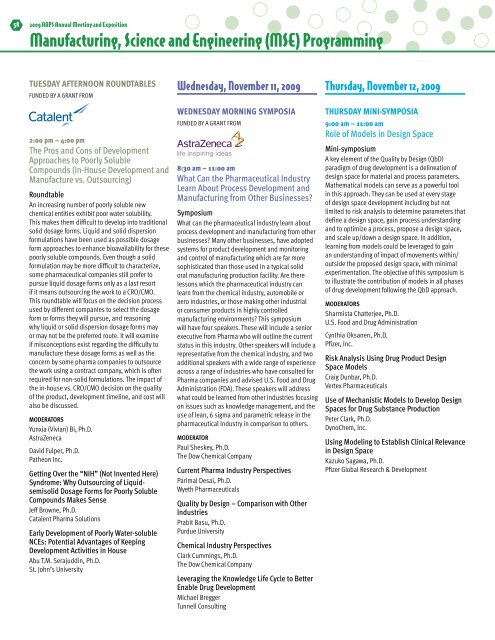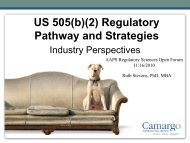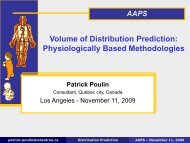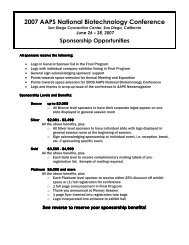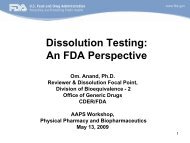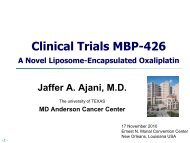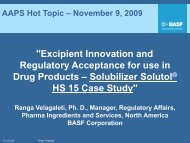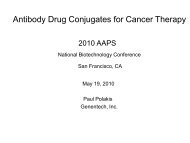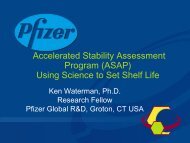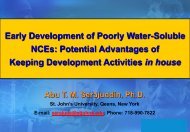Preliminary Program - American Association of Pharmaceutical ...
Preliminary Program - American Association of Pharmaceutical ...
Preliminary Program - American Association of Pharmaceutical ...
You also want an ePaper? Increase the reach of your titles
YUMPU automatically turns print PDFs into web optimized ePapers that Google loves.
58<br />
2009 AAPS Annual Meeting and Exposition<br />
Manufacturing, Science and Engineering (MSE) <strong>Program</strong>ming<br />
TUESDAY AFTERNOON ROUNDTABLES<br />
Funded by a Grant from<br />
2:00 pm – 4:00 pm<br />
The Pros and Cons <strong>of</strong> Development<br />
Approaches to Poorly Soluble<br />
Compounds (In-House Development and<br />
Manufacture vs. Outsourcing)<br />
Roundtable<br />
An increasing number <strong>of</strong> poorly soluble new<br />
chemical entities exhibit poor water solubility.<br />
This makes them difficult to develop into traditional<br />
solid dosage forms. Liquid and solid dispersion<br />
formulations have been used as possible dosage<br />
form approaches to enhance bioavailability for these<br />
poorly soluble compounds. Even though a solid<br />
formulation may be more difficult to characterize,<br />
some pharmaceutical companies still prefer to<br />
pursue liquid dosage forms only as a last resort<br />
if it means outsourcing the work to a CRO/CMO.<br />
This roundtable will focus on the decision process<br />
used by different companies to select the dosage<br />
form or forms they will pursue, and reasoning<br />
why liquid or solid dispersion dosage forms may<br />
or may not be the preferred route. It will examine<br />
if misconceptions exist regarding the difficulty to<br />
manufacture these dosage forms as well as the<br />
concern by some pharma companies to outsource<br />
the work using a contract company, which is <strong>of</strong>ten<br />
required for non-solid formulations. The impact <strong>of</strong><br />
the in-house vs. CRO/CMO decision on the quality<br />
<strong>of</strong> the product, development timeline, and cost will<br />
also be discussed.<br />
Moderators<br />
Yunxia (Vivian) Bi, Ph.D.<br />
AstraZeneca<br />
David Fulper, Ph.D.<br />
Patheon Inc.<br />
Getting Over the “NIH” (Not Invented Here)<br />
Syndrome: Why Outsourcing <strong>of</strong> Liquidsemisolid<br />
Dosage Forms for Poorly Soluble<br />
Compounds Makes Sense<br />
Jeff Browne, Ph.D.<br />
Catalent Pharma Solutions<br />
Early Development <strong>of</strong> Poorly Water-soluble<br />
NCEs: Potential Advantages <strong>of</strong> Keeping<br />
Development Activities in House<br />
Abu T.M. Serajuddin, Ph.D.<br />
St. John’s University<br />
Wednesday, November 11, 2009<br />
WEDNESDAY MORNING SYMPOSIA<br />
Funded by a Grant from<br />
8:30 am – 11:00 am<br />
What Can the <strong>Pharmaceutical</strong> Industry<br />
Learn About Process Development and<br />
Manufacturing from Other Businesses?<br />
Symposium<br />
What can the pharmaceutical industry learn about<br />
process development and manufacturing from other<br />
businesses? Many other businesses, have adopted<br />
systems for product development and monitoring<br />
and control <strong>of</strong> manufacturing which are far more<br />
sophisticated than those used in a typical solid<br />
oral manufacturing production facility. Are there<br />
lessons which the pharmaceutical industry can<br />
learn from the chemical industry, automobile or<br />
aero industries, or those making other industrial<br />
or consumer products in highly controlled<br />
manufacturing environments? This symposium<br />
will have four speakers. These will include a senior<br />
executive from Pharma who will outline the current<br />
status in this industry. Other speakers will include a<br />
representative from the chemical industry, and two<br />
additional speakers with a wide range <strong>of</strong> experience<br />
across a range <strong>of</strong> industries who have consulted for<br />
Pharma companies and advised U.S. Food and Drug<br />
Administration (FDA). These speakers will address<br />
what could be learned from other industries focusing<br />
on issues such as knowledge management, and the<br />
use <strong>of</strong> lean, 6 sigma and parametric release in the<br />
pharmaceutical industry in comparison to others.<br />
Moderator<br />
Paul Sheskey, Ph.D.<br />
The Dow Chemical Company<br />
Current Pharma Industry Perspectives<br />
Parimal Desai, Ph.D.<br />
Wyeth <strong>Pharmaceutical</strong>s<br />
Quality by Design – Comparison with Other<br />
Industries<br />
Prabit Basu, Ph.D.<br />
Purdue University<br />
Chemical Industry Perspectives<br />
Clark Cummings, Ph.D.<br />
The Dow Chemical Company<br />
Leveraging the Knowledge Life Cycle to Better<br />
Enable Drug Development<br />
Michael Bregger<br />
Tunnell Consulting<br />
Thursday, November 12, 2009<br />
THURSDAY MINI-SYMPOSIA<br />
9:00 am – 11:00 am<br />
Role <strong>of</strong> Models in Design Space<br />
Mini-symposium<br />
A key element <strong>of</strong> the Quality by Design (QbD)<br />
paradigm <strong>of</strong> drug development is a delineation <strong>of</strong><br />
design space for material and process parameters.<br />
Mathematical models can serve as a powerful tool<br />
in this approach. They can be used at every stage<br />
<strong>of</strong> design space development including but not<br />
limited to risk analysis to determine parameters that<br />
define a design space, gain process understanding<br />
and to optimize a process, propose a design space,<br />
and scale up/down a design space. In addition,<br />
learning from models could be leveraged to gain<br />
an understanding <strong>of</strong> impact <strong>of</strong> movements within/<br />
outside the proposed design space, with minimal<br />
experimentation. The objective <strong>of</strong> this symposium is<br />
to illustrate the contribution <strong>of</strong> models in all phases<br />
<strong>of</strong> drug development following the QbD approach.<br />
Moderators<br />
Sharmista Chatterjee, Ph.D.<br />
U.S. Food and Drug Administration<br />
Cynthia Oksanen, Ph.D.<br />
Pfizer, Inc.<br />
Risk Analysis Using Drug Product Design<br />
Space Models<br />
Craig Dunbar, Ph.D.<br />
Vertex <strong>Pharmaceutical</strong>s<br />
Use <strong>of</strong> Mechanistic Models to Develop Design<br />
Spaces for Drug Substance Production<br />
Peter Clark, Ph.D.<br />
DynoChem, Inc.<br />
Using Modeling to Establish Clinical Relevance<br />
in Design Space<br />
Kazuko Sagawa, Ph.D.<br />
Pfizer Global Research & Development


